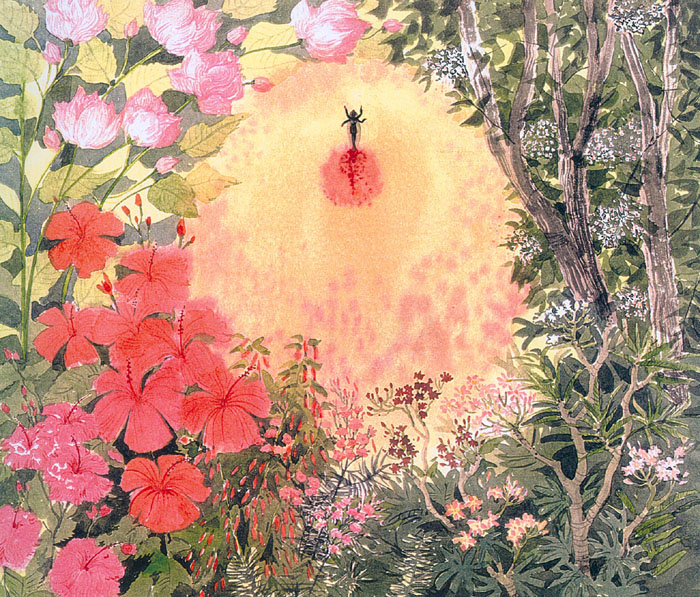 |
|
Panchvati...
The grove of five sacred trees: Vata, Peepal, Neem, Amla and Bilva,
first mentioned in the Ramayana where first Rama, Lakshmana and
Sita lived in exile for fourteen years.
|
|
Projects
/ Programmes
Sacred
Groves and Gardens
The
Shri Kunja aims to revive and re-create the unique ambiance of
sacred groves, gardens and sacred trees that reflect, India’s
traditional forest culture of udyans and vatikas.
This will act as a unique retreat cum study centre about India’s
sustainable vision of earth spirituality.

|
| |
|
|
Ashoka
Vatika
The Ashoka Vatika is inspired from the description of the Ashoka
Grove where Sita took refuge after being abducted by Ravana. We
hear about the beauty of the Ashoka Grove through the voice of Hanuman:
He saw Sala, Ashoka, Bhavya, Champaka, Uddalaka, Nagavriksha, Mango
and Kapimukha trees in flower with clumps of amras intertwined with
hundreds of creepers. And Hanuman leaping down into that enchanting
grove, like an arrow shot from a bow, entered that garden resembling
the rising sun.
Ramayana Sundara Kanda 14.3-4 |
|
 |
| |
|
|
Vrindarani
Ka Kunja
The Bhagavata Purana gives a vivid description of the trees sacred
to Krishna worship. In choruses, the gopies sought for Krishna,
forest to forest embracing trees:
Oh Ashvattha! Oh Plaksa! Oh Nyagrodha! Have you seen the son of
Nanda who has absconded, stealing away our hearts by his captivating
smiles and bewitching glances?
Oh Kurabaka, Ashoka, Naga, Punnaga and Campaka trees! Did the younger
brother of Balarama who humbles the pride of proud women by his
smiles pass this way?
Oh blessed Tulasi (basil) to whom the feet of Lord Govinda (Krishna)
are so dear! Have you seen Acyuta, so very beloved of you, wearing
you (in a wreath) swarming with bees. (Addressing various flowering
trees) Oh Malati! Oh Jati! Oh Yuthika! Was Madhava seen by you giving
you delight by the touch of his hands, while passing by the way?
(Invoking other trees)
Oh mango tree (of the Cuta variety)! Oh Priyala, Panasa (jackfruit
tree), Asana, Kovidara, Jambu (rose-apple tree), Arka (the sun plant),
Bilva (the wood-apple tree), Bakula, Amra (a variety of mango tree),
Kadamba and Nipa trees and other trees on the bank of the Yamuna-Born
as you are for the benefit of others! May you direct the path of
Krishna to us.
Bhagavata Purana 10.30, 5-7, 8-9 |
|
 |
| |
|
|
Garden
of Nine Planets
The Ark plant popularly known as a 'vegetable form of mercury' is
located in the centre. The plant yields a white latex used to cure
scabies, dysentery, jaundice, epilepsy, asthema and cholera. Saturn,
the energy of the Sun is located in the west, is represented by
Acacia feruginea, a tree with small bipinnately compound leaves.
Jupiter lies at the North and is said to confer all around beneficence;
Venus in the East confers economic well-being; Mars in the South
is malefic and is represented by Uttarani, a small herb. Rahu and
Ketu represented by grasses used in special ceremonies and tide
over the negative influences. |
|
 |
| |
|
|
Garden
of Twelve Zodiac signs
The solar zodiac, consists of a familiar division of the sun's path
into twelve zones. Each zodiac sign has its respective letter and
a numerical symbol. It is interesting to observe that each zodiac
sign, over a period of history, gets associated with a certain plant,
tree or a shrub. The zodiac signs personified in their plant form
served as tool for healing. The zodiac plants were considered as
protectors of malefic influences generated through the natural course
of the planets. |
|
 |
| |
|
|
| The
lunar zodiac charts the clusters of stars lying on the moon's path
dividing the ecleptic into 27 (or 28) parts, each with their respective
constellation. These constellations are known as Nakshatras, a term
used to designate both asterisms, stars or star-groups. These have
their respective symbols. Like the Navagrahas and the Rashis, these
too have their plant representations. The Nakshatra Vana has also
been laid out in a circle to coincide with the natural circular
movement of the moon, which waxes, wanes and then returns to its
original wholeness. Each of the Nakshatras has its plant code and
is propitiated on certain auspicious periods during the course of
the year. |
|
 |
| |
|
|
Devi Ka Bagicha
The flower associated with the great goddesses, Durga, Kali and
Lalita-Tripurasundari, commonly known as Japa. Often the divine
radiance of the goddess is compared to the vermilion hues at dawn
which flash forth like the ruddy streaks of the Japa flower. The
full redness of Japa recalls the rajasika active aspect of creation
represented by the dynamic role that the goddess performs, as 'Shakti'
or the cosmic energy of the universe. |
|
Devi
Ka Bagicha

|
|
 |

